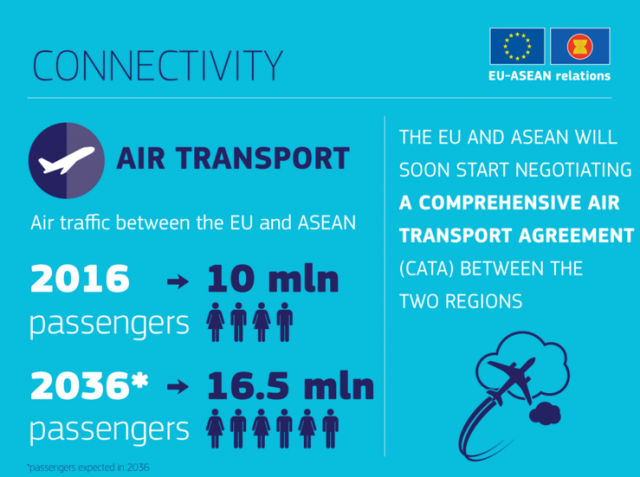In Bali on September 26-27, the Ministers of Transport of ASEAN will meet their European counterparts at the Asia Europe (ASEM) Meeting of Ministers of Transport. Violeta Bulc, the European Commissioner for Transport, provides this glimpse of how the two regional blocs are pursuing connectivity in this statement ahead of the Bali meeting.
The ASEAN-EUROPE agenda on Connectivity is growing and the EU is committed to strengthening its engagement even further. As we are a major economic player in Southeast Asia, the first investor and the second largest trading partner of ASEAN, we need to ensure that our cooperation on Connectivity – both in hard and soft infrastructure – gathers pace accordingly.
When it comes to transport and connectivity we certainly live in exciting times! By 2030, it is expected that 60% of us will live in urban areas. Air traffic is projected to grow to 7.2 billion passengers in 2035; a near doubling of last year’s 3.8 billion air travelers.
There are estimates that the world needs to invest an average of USD 3.3 trillion in infrastructure, much of it for transport needs, just to support currently expected rates of growth. The so-called “disruptive” technologies (e.g. automated vehicles and drones) will revolutionize the manner in which we travel but will also bring many challenges.
To further engage Europe in ASEAN, on the margins of the ASIA EUROPE (ASEM) Meeting of Ministers of Transport in Bali on 26-27 of September, I will be also meeting the Ministers of Transport of ASEAN. I look forward to discussing what we are already doing together in the growing ASEAN-EUROPE agenda (bringing our two regions closer together), but also in the internal ASEAN Connectivity agenda (bringing the ASEAN countries closer together).
The ASEAN-EUROPE Connectivity agenda is underpinned by the ongoing region to region negotiations for an EU-ASEAN Comprehensive Air Transport Agreement (CATA). This comprehensive Air Transport Agreement will be the first such block-to-block accord, and will contribute to substantially deepen our aviation links. We are also working closely together on aviation safety while showing leadership in international fora on both cutting aviation and maritime emissions. But transport goes of course beyond aviation, and we are about to launch a first ever EU-ASEAN High Level Dialogue on Multimodal Transport at Senior Official level in Singapore on 11 October.
The EU is also supporting ASEAN efforts to connect its peoples and its markets: We are engaged supporters of ASEAN’s Master Plan on Connectivity 2025 (MPAC 2025), supported in different ways though thematic dialogues and our EU/ASEAN Cooperation budget of over 200 million euros, to make Connectivity a reality in the region and beyond.
It is however essential that we continue to coordinate well our efforts. Overall, our success will depend on the respect of three broad principles. We must embrace “inclusiveness” to ensure that all countries benefit from these new routes for their economic development. Second – “reciprocity” is key in terms of market access, sharing know-how, respect for rules and a level-playing field. And finally – “Sustainability” is a must in order to promote economically, socially and environmentally sound projects. Indeed, we must honour the Paris agreement so that emissions from our transport systems become part of the solution rather than being much of the problem.
The EU is determined to work with ASEAN to find sustainable connectivity solutions, and I very much welcome working with our ASEAN partners on this very strategic agenda.




